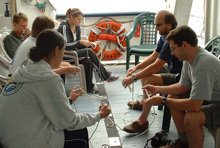
Dr. Ross (on the right, in sunglasses) teaches an impromptu knot-tying class as we return offshore to resume the expedition. Click image for larger view and image credit.
Back in the Groove
October 27, 2005
Dr. Steve Ross
Lead PI & Chief Scientist
University of North Carolina at Wilmington (currently on assignment to US Geological Survey)
Visiting an interesting port can be a refreshing break on a long research cruise. But it is less welcomed when forced upon us by unpleasant weather. In fact, it is disruptive. From my perspective as chief scientist our three plus days in Charleston (resulting from passage of hurricane Wilma) represent lost samples, loss of unique data about unexplored territory, and just as bad, a disruption of the rhythm we had developed at sea. It had taken the first two days to settle into unfamiliar patterns of life at sea: longer working hours (12-16 hours per day), some of us becoming nocturnal (the night watch), less sleep (4-5 hours per night). Now, back at sea, we are reestablishing those patterns.
It could have been worse, though. As we steamed back offshore to our first dive site after the port layover, the seas grew calmer and the north winds less intense. A north wind blowing against the Gulf Stream can generate very unpleasant seas. The run out was full of preparations, such as rerigging the trawl cables (cutting and joining stainless steel cable is a challenge), mapping sites, setting out samples to dry, repositioning gear, adjusting the dive plan, consulting with the captain about weather predictions over the next 2 days, and I even had time to give a small class in marlinspike seamanship (knot tying). Then, when we arrived at the Savannah coral bank dive site, conditions were good for the afternoon dive. This area is quite different from most of our other sites. There are a diversity of corals, but they are more scattered. The mounds do not rise as high off the bottom and have more gentle slopes. A noticeable difference is the greater amounts of sediment around and on the corals. We theorized that this may be because this site is more inshore than some other sites, closer to large, sediment laden rivers of coastal Georgia. Perhaps these coral banks undergo varying degrees of being buried and uncovered depending on bottom currents and sediment delivery to the area. Nevertheless, it is a good comparison to our other study sites and will provide data for a better regional perspective.

Sample of consolidated substrate collected at the Savannah banks. Attached are several corals, hydrozoans and other small invertebrates. In addition, other animals including polychaete worms were using this rock as habitat. Click image for larger view and image credit.
The afternoon dive was quite successful. We looked everywhere from surface to bottom for evidence of hurricane Wilma, but none was found. Bottom visibility was very good and currents were moderate. The sub arrived back on deck after dark, and the crew struggled to find the smooth rhythm of the past week. It was a bit uncoordinated at first. Small samples of a diversity of corals (Lophelia, Madrepora, Stylaster, antipatharians, and a few solitary species) were collected to meet many of our science objectives. Our colleague from Scotland, Dr. Roberts, commented that just one of the animal covered rocks we brought back could keep a scientist busy for months cataloguing the array of life attached to it. Several long habitat-animal transects were run with the video cameras. Crabs and fishes were collected.
As one crew sorted and catalogued, we quickly we jumped into the night watch pattern, as we decided weather favored a run farther offshore to the Stetson Bank. The ship was given a course, and part way there I and the night crew conducted a 3-4 hour sonar survey of a potential dive target (maybe for Friday). Then, on to the Stetson area, where at 4 am the night crew transected our target dive site and made sonar runs over a huge trench (the western Stetson escarpment) that covered a depth profile of 150 meters. I joined the night crew at about 5:30 am, reviewed those data and finalized the morning plan. The sub went in the water on schedule as the sun rose to reveal one of our calmest days yet, at our deepest (700 meters) and farthest site offshore (150 nautical miles out) so far. Life is good and we are back in the groove.
Life on the Edge will be sending daily reports from Oct 16 - Nov 4. Please check back frequently for additional logs from this expedition.
Sign up for the Ocean Explorer E-mail Update List.

























